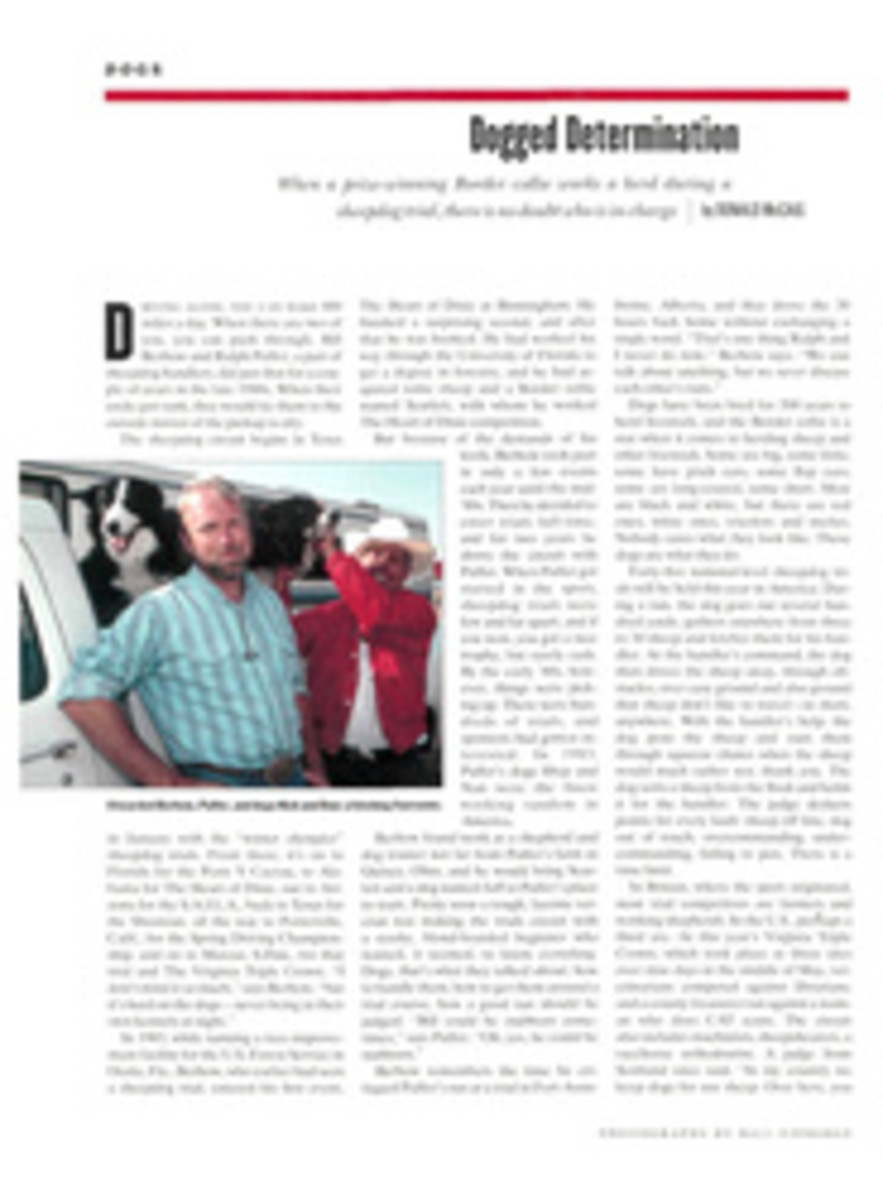
Ringing in a Second Century
Whether it is experienced for the first or the 500th time, the flush of a rooster pheasant is breathtaking. Even from beneath the point of a dog, the bird always seems to be coming from nowhere but heading for somewhere—in a hurry.
Against a faded autumn setting of corn or cattails, the iridescent crimsons, blues and ambers of a flushing cockbird, which often extends a full yard from ivory beak to tail tip, almost overpower the eyes with sudden contrast. For the ears there's a roar of beating wings and a startling cackle that too often turns into a mocking cry when a shot is missed...or not taken at all. Many a novice has stood spellbound, tightly gripping a forgotten shotgun.
Every year pheasants lure thousands of hunters, ranging from farm kids on a stolen respite from school-work and chores, to CEOs whose private jets deliver them to stubble-filled fields. Those who outwit a cunning cockbird come away with the fulfillment of a successful hunt, along with a gourmet dinner.
But this fall the flavor of the meals, the thrills and memories of the hunt, will have an even greater significance. Though the long-tailed birds by now seem as all-American as whitetails and bobwhites, ring-necked pheasants are relative newcomers to this country. With the first flushes of the season, sportsmen will begin commemorating the 100th year of hunting wild pheasants in America.
"Originally a bird of Asia, pheasants have always been a popular import. They were showing up in Greece around 1300 B.C. and had been brought into England as early as 250 A.D.," says Chris Dorsey, author of Pheasant Days (to be published in the spring by Voyageur Press). "Attempts were made to establish pheasant populations in America beginning in the 1730s. Even George Washington had several pheasants shipped from England to Mt. Vernon."
As was the case with Washington, most such attempts to establish ringnecks in America ended in failure. "The biggest problem was probably bad breeding," says Dorsey. "It seems that the birds were largely domesticated stock that was imported from England. Then, as now, releasing pen-reared stock into the wild does not work well. They just can't withstand the rigors of nature as well as wild game."
It wasn't until late in the 19th century that wild pheasants established a viable toehold in America. Judge Owen N. Denny, U.S. consul general in Shanghai, was the catalyst for this breakthrough. In late 1881 or early 1882, Denny shipped between 50 and 70 wild Chinese pheasants to the Denny family homestead in Oregon. After being released in the Willamette Valley, the pheasants flourished. Just 10 years later, when the first official ring-neck season was declared, a bag of nearly 50,000 birds was taken on opening day.
This success led to the establishment of wild pheasant populations, all of which can be traced back to Denny's stock, in 39 states by 1907. Hunting seasons are now held in 32 states. A few other states have isolated, unhunted flocks, while some, mostly in the deep South, can't support a population.
The imported birds throve in areas that were patchworks of small farms. Pheasants could easily grow fat while feeding in the grainfields, while neighboring grass and weed patches offered optimum conditions for nesting and winter cover. A bird that was once nonexistent in the U.S. became a major prize within the span of a few decades. In 1945, for example, 40 years after the bird's introduction to South Dakota, it was estimated that there were more than 16 million pheasants in that state.
"We had some phenomenal pheasant populations right on through the early 1960s," says Jeffrey Finden, executive director of Pheasants Forever, a conservation group that is based in Vadnais Heights, Minn., and is dedicated to protecting and providing habitats for the birds. "It was really extraordinary in the late '50s and early '60s."
By that time, the Department of Agriculture's soil-bank programs were in full swing. Farmers were encouraged to let a lot of their ground lie fallow and produce weeds, or to plant cover crops. Acres that once grew corn began growing pheasants. People who went hunting in those days still talk about it with wonder.
But then, the pheasant population went into a nosedive. According to Finden, there were always year-to-year population variables, even during the heyday of the soil-bank programs. An extreme winter could starve much of a population; an especially wet spring could destroy nests and broods, thereby damaging reproduction rates. Normally the pheasants recovered quickly, but in the early 1970s that changed.
"With the stroke of a pen the United States Department of Agriculture wiped out a lot of pheasants," says Finden. "When Secretary of Agriculture Earl Butz told farmers to start farming from road to road, it was disastrous for all wildlife—especially pheasant. It's been proven over and over that regulated hunting doesn't hurt a population. [Especially pheasant hunting, because only the polygamous males are shot.] Habitat loss is always the major threat to wildlife."
The result of the Department of Agriculture's revised policy was an inland sea of virtually contiguous corn and soybean fields. Pheasants were pushed onto tiny islands of cover, mostly along fencerows or on untillable land. "In some places the change was so gradual that many people would never have noticed it," says Finden. "It took about 25 years, but we lost five million acres to row crops here in Minnesota."
Changes in agricultural practices have chipped away at pheasant populations in less visible ways as well. "Many people don't realize that pesticide use has tripled since the 1950s," says Finden. "It's obviously not healthy for young chicks if they get directly sprayed, but the most drastic effect is what it does to the food chain. For the first four weeks of life, pheasant chicks subsist almost totally on insects that provide needed moisture and protein." Unfortunately for pheasant chicks, the insects that provide them with sustenance are often the very insects that are targeted for pesticides.
Herbicides are also in wide use, wiping out the weeds that mature pheasants use for cover and feed. In addition, changes in harvesting techniques have claimed habitat. Each year more and more farmers immediately follow their harvest combines with plows. The stubble fields that once provided winter food for pheasants and other wildlife now offer nothing but dirt clods.
As it happened, some states weathered the agricultural storms better than others. Kansas, Iowa, Nebraska and South Dakota all maintained populations of two to three million birds even during the worst years. Pheasants Forever estimates that between 1971 and 1986 the pheasant population declined 33% in the Midwest and 67% in the Plains and western states.
Appropriately for this 100th hunting season, the picture is brightening. In the past decade state game agencies have channeled funds from hunting licenses and equipment taxes into habitat by means of land-buying programs. Conservation groups in many states are also pushing governmental groups to protect as much habitat as possible. Laws prohibiting the mowing of road ditches until after the nesting season have had a particularly positive effect on pheasant numbers in Minnesota and Iowa.
The activities of Pheasants Forever have certainly played a major role in the ringneck's rescue. "Just since 1987 we've planted 4½ million trees on a total of 5,800 different projects," says Finden. "In that same time we've put in 33,253 food plots on over 407,956 acres and have added over 124,000 acres of nesting cover on 7,453 separate projects."
Ironically, the biggest gift of all has come from the USDA. "The farm bill of 1985 [which, among other provisions, specifically took marginal land out of production] has been a real boon to pheasants," says Finden. "The Conservation Reserve Program has put about 42 million acres of what were once crops back into grassland, and the farmers can't do much to it for 10 years. The program was designed to take eroding cropland out of production, but it's providing a tremendous amount of cover for wildlife."
An upswing in pheasant numbers will no doubt bring an upswing in many rural economies. The South Dakota Department of Tourism estimates that resident pheasant hunters spend more than $10 million for lodging, food and supplies in that state during every fall season. And there are a few places where enterprising farmers have learned that they can make as much from wild pheasant as from corn or wheat.
J.R. Dienst remembers the glorious hunting of the soil-bank years near his Lakin, Kans., farm. In fact, for years he managed a small portion of his land just so that he and a few friends could enjoy hunting the way it was in "the good old days."
Now all who pay the modest fee can get the same experience at Dienst's Pheasant Creek Hunting Service. The third-generation farmer has amassed more than 30,000 acres of wildlife-rich thickets, former pastures, food plots and unplowed stubble fields.
After hunting Dienst's land last fall, Dorsey said, "It was like a step back in time...a 40-year step. In a day and a half we easily saw between 800 and 1,000 pheasants. It's a prime example of what simply providing the right habitat can do. I'll be back this fall...to celebrate the 100th season seeing pheasant hunting at its best."
PHOTO
ROBERT MAIER/ANIMALS, ANIMALS
Michael Pearce is a free-lance writer who specializes in business and outdoor subjects.

